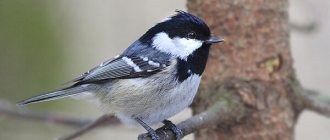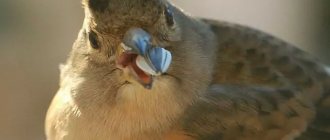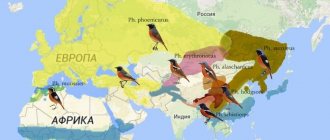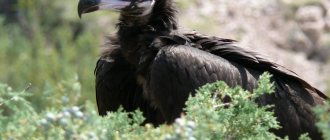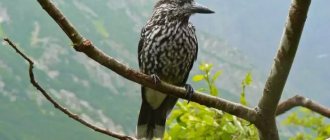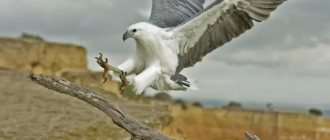- Wild animals
- >>
- Birds
The yellow-headed wren is the smallest inhabitant of our country and Europe. It is not easy to notice this nimble and active bird in the tree crown, because it is so tiny. The little wren is said to replace hummingbirds throughout the northern hemisphere. We will describe in detail the appearance of this interesting bird, characterize its habits, food preferences, places of permanent residence, features of the mating season and avian character.
Origin of the species and description
Photo: Yellow-headed Kinglet
The yellow-headed kinglet is classified as a member of the kinglets family, the order Passeriformes and the genus kinglets. As already noted, this is a very tiny inhabitant of mainly spruce forests. The bird received its royal name due to the presence of a bright yellow stripe on its head, which resembles a crown made of gold. In Germany, the kinglet is called the “winter golden cockerel” because it flies to this country only in winter. Previously, in Rus', the bird was called a “carnation,” apparently because of its miniature size.
Interesting fact: In females, the crown stripe has a lemon-yellow tint, while in males it is yellowish-orange in color. In males it is wider.
Video: Yellow-headed kinglet
Despite the fact that the wren was not very tall, legends are formed about it. One of them testifies to his daring and dexterity. They say that once upon a time a dispute arose between the birds about which of them would fly closest to the sun. It seemed that the proud eagle was in the lead in this fight, but at the very last second a tiny kinglet flew out from under the eagle’s wings, rising much higher than the bird of prey. The size of the yellow-headed kinglet is indeed very small. The length of the bird's body is from 9 to 10 cm, and its weight ranges from 4 to 8 grams.
In terms of size, the yellow-headed kinglet is slightly inferior:
- wren;
- king warbler;
- red-headed kinglet
It is worth noting that ornithologists have identified 14 subspecies of this bird, which differ not only in the territory of their residence, but also in some nuances of feather color.
List of species[ | ]
- Yellow-headed kinglet ( Regulus regulus
) (Linnaeus, 1758) Canary kinglet (
Regulus regulus teneriffae
) Seebohm, 1883
) (Temminck, 1820)
) (Harcourt, 1851)
) Ogilvie-Grant, 1906
) Lichtenstein, 1823
) (Linnaeus, 1766)
Appearance and features
Photo: Yellow-headed wren Author: Svetlana Medvedeva (@msvetlana012018)
So, we have already found out that the most important features of the yellow-headed kinglet are its miniature size and the rich yellow “crown” at the very top of its head. The entire figure of the baby king resembles a ball; its physique is similar to warblers. The length of its wingspan varies from 13 to 17 cm.
The king's tail is not long, and the beak looks like an awl, very thin and sharp, but short and almost black in color. There are no obvious differences between the sexes in birds. Only, as mentioned, the shades of the “crowns” on the head vary. The yellow feathers on the head stick out like a tuft when the wren arrives in excitement, and have a contrasting black edge. The main tone of the plumage is greenish-olive, the bird’s belly is much lighter than the dorsal part. On the darker wings, a pair of white transverse stripes stand out clearly.
The king's eyes are quite large and resemble round, shiny, black beads. A whitish outline is noticeable around them. The iris of the eye is dark brown. In the area of the forehead and cheeks, whitish plumage is also observed. The limbs of the bird have a grayish-olive color scheme. The paws are four-toed, three toes point forward, and the fourth is directed in the opposite direction, which allows the birds to be tenacious and nimble, moving from branch to branch. The young of the kinglets are similar to their adult relatives, only they do not have a yellow crown on their heads, this happens until the first autumn, which the birds have to endure, then the bright yellow feature begins to gradually appear, becoming more and more noticeable.
Now you know what a yellow-headed wren looks like. Let's see where it is found.
Raising offspring
Two clutches are laid per year, including from 6 to 12 white eggs. You may notice a creamy or yellow coating. Dimensions usually do not exceed 15x11 mm. The chicks have very little fluff. Just a little gray soft covering on the head.
For a whole week, the female does not fly out of the nest in order to monitor her offspring and ensure their safety. The male supplies her and her children with food. Upon reaching the age of 17 to 22 days, the chicks can go outside on their own, sit on a branch, and then even fly into the air.
When the nesting season ends, the birds form flocks, united with other species, and jointly search for food. On average, a kinglet lives 2 years. The longest-liver turned out to be an individual from Denmark, whose existence lasted 5 years and 5 months.
Where does the yellow-headed kinglet live?
Photo: Yellow-headed wren in Russia
Yellow-headed kinglets have chosen almost all of Eurasia, the Azores and Canary Islands. To the north of Western Europe, nesting birds can be found almost everywhere where the natural biotopes are suitable for it. To the south, the bird can be found only in certain places; its range is divided into separate areas. Kinglet nests have been found on the Iberian Peninsula, Italy, southwestern France, Romania, and the Balkans. You will not find the kinglet in the northern part of Scandinavia; there are places where this bird appears only in winter during migration (Germany).
Interesting fact: Scientists have found that the habitat of this miniature bird almost completely coincides with the habitat of common spruce, fir and some other varieties of Asian spruce.
In the vastness of our country, the wren inhabited:
- Black Sea coast;
- Crimea;
- Karelia;
- Mountain Caucasus;
- Altai mountain ranges;
- Kola Peninsula;
- Sakhalin;
- Kuril Islands.
The Russian habitat of the bird reaches the Nizhny Novgorod, Tambov and Penza regions. The yellow-headed wren also lives in the spaces of Ukraine.
As you can see, the bird has perfectly adapted to the mountainous terrain, so you can meet it:
- in the Urals;
- Tien Shan;
- in the Himalayas;
- on the Iranian Elborz;
- in the mountain ranges of Tibet;
- on the territory of the Armenian Taurus;
- in the Alps.
The wren usually lives at altitudes of about one and a half kilometers, although in the Himalayas it can be found at an altitude of four kilometers; in the Swiss Alps, birds fly into mountains higher than 2 km. During seasonal movements of the kinglet can be found in the vast expanses of Egypt, China and Taiwan.
Yellow-headed kinglets give their preference to tall spruce forests, where sometimes there are inclusions of mountain pine and fir. In mixed forests, birds nest much less frequently, preferring spruce-broad-leaved forests and high-mountain cedar forests. But the wren does not like forests where larch and common pine grow, so it never settles there. In the Canary Islands, the bird lives in the laurel forest and in places where Canary pine grows. On the territory of the Azores Islands, the kinglet has adapted to live in areas where Japanese cedar grows and in juniper groves, because. The laurel forests here were almost all cut down.
Interesting Facts
There is a custom in Ireland. On the second day of Christmas, St. Stephen's Day, adults and children catch kinglets and kill them. The Irish give a simple explanation for their actions. Once upon a time, Stephen, one of the first Christians, was stoned to death. The place where the Christian was hiding was shown to his persecutors by a bird - a wren. She still has to pay for this to this day.
One of the versions that explains the names of the kinglets, that is, the little king, is associated with a fable. Some attribute the authorship to Aristotle, others to Pliny. The point is this. Birds fought for the right to be called the king of birds. To do this, it was necessary to fly higher than everyone else. The smallest one hid on the eagle's back. I used it as a transport, saved my energy and ended up above everyone. So the little birdie became a king.
At the University of Bristol, ornithologists became convinced that kinglets understand not only the signals of relatives and animals neighboring them. They quickly learn to understand what birds unknown to them are screaming about. After several listenings, the kinglets began to clearly respond to the recorded alarm signal, which they had never heard before.
What does the yellow-headed wren eat?
Photo: Yellow-headed Kingbird
The menu of the yellow-headed kinglet is very diverse, it contains both animal food and dishes of plant origin. The latter predominate in the diet in cold times, when it becomes very difficult to find small animals.
So, the miniature wren is not averse to a snack:
- caterpillars;
- aphids;
- springtails;
- spiders;
- small bugs;
- cicadas;
- stoneflies;
- caddisflies;
- dipterous;
- Hymenoptera;
- bark beetles;
- long-legged mosquitoes;
- hay eaters;
- seeds of coniferous trees;
- berries and other fruits.
This small bird cannot catch large prey; the kinglet cannot tear it apart with its beak, as sparrows and titmice often do; it always swallows the caught prey whole. Basically, the wren finds food in coniferous branches, carefully examining needles, cracks in the bark, and scales of cones. The bird grabs winged insects mid-flight, hovering in the air like a hummingbird. Very rarely, the baby kinglet descends to the ground to search for a snack; it prefers to camouflage itself in the tree crown. When feathered babies are thirsty, they drink dew and use raindrops to get drunk.
The tiny dimensions of the king determine the peculiarities of its feeding, which is practically uninterrupted. The wren continues to consume food as it sings its trills and sets up its nesting area. This is due to the fact that it has a very rapid metabolism and a small stomach size. The food that fits into a tiny stomach cannot completely satisfy an overly active bird, so the wren eats constantly to be agile and energetic. During the day, he eats a volume of food that is twice his own weight.
Interesting fact: If a kinglet has to fast for 12 minutes, its body weight at that moment decreases by a third. And an hour's fasting can lead to the death of a bird.
Nutrition
The basis of the king's diet is insects. Most often these are arthropods with soft cuticles: spiders, aphids, soft-bodied beetles. Even more valuable are the eggs and larvae of insects. Kinglets, with the help of their thin beak, take out their food from cracks in the tree bark, from under lichen growths.
Typically, kinglets live on the upper floors of the forest, but periodically descend to the lower tiers or even to the ground. Here they pursue the only goal - to find food. Spiders often help them. Firstly, the kinglets eat them themselves, and secondly, they peck out spider prey entangled in sticky threads.
Despite its modest size, the wren has a huge appetite.
Less commonly, kinglets attack flying insects. The kinglet diversifies its protein diet with seeds of coniferous plants. They manage to drink nectar; in early spring they were observed consuming birch sap flowing from tree wounds.
Kinglets are constantly busy searching for food. They pause their singing to have a snack. It is explainable. Birds are small, metabolic processes in the body proceed very quickly. Requires continuous feeding. If the wren does not eat something within an hour, it may die of hunger.
Features of character and lifestyle
Photo: Yellow-headed kinglet from the Red Book
It is difficult for small creatures to live alone, so kinglets can be called collective birds. Often during sleep they snuggle together to keep warm. In general, these are very dexterous and energetic birds that are constantly on the move, seething with enthusiasm and swiftness in the tree crown.
As it has already turned out, kinglets prefer spruce forests, where they are very difficult to notice in the branches of spruce, because The camouflage of these birds is excellent. Birds' tenacious legs allow them to hang on branches even upside down, at these moments the kings look like Christmas tree balls. If it is very difficult to see the kinglet, then it can be detected by singing, the range of which is very high and resembles the sounds of “qi-qi-qi”.
Among the kinglets there are both sedentary birds and migratory (nomadic) birds. The former are constantly tied to one place of deployment and do not leave it, the latter migrate over long distances or wander to shorter distances from their permanent place of residence. As a rule, birds living in the south are sedentary, and northern birds are migratory. Typically, kinglets do not leave the growing limits of spruce forests.
Interesting fact: Migrating kinglets can cover from 200 to 800 km in one day, only if there is a fair wind.
Often during migrations they stop within the boundaries of human settlements, where they rest and refresh themselves. It should be noted that tiny birds do not feel fear of humans and treat people quite loyally, without shying away or fearing bipeds.
Taming
The technology used to catch kinglets is interesting. For this purpose, semolina poultry, onions, and hanging nets are used. The bird is very trusting, so it does not offer much resistance. There is no need to tie the wings. The best time for catching is early to mid-autumn.
It is better to house the kinglets not individually, but in pairs or groups. To do this, you need a large cage with branches on which they can sit. The issue of feeding deserves great attention, since these creatures are so tender that they can die from disruption of their diet.
The owner should also know that during molting, previously friendly birds may begin to conflict and show aggression, so at this time it is better for them to live separately. This wonderful creation can turn any home into an exotic castle.
Social structure and reproduction
Photo: Yellow-headed kinglet in nature
The wedding season for yellow-headed kinglets lasts from April, spanning the beginning of summer. The birds attract the opposite sex by puffing up their bright crest, which at this time even more resembles a crown. The fluttering of wings, the singing of roulades, the spreading of short tails serve as signs of attracting attention.
Having found a partner, the males acquire their own area, which they carefully guard from all encroachments. If a competitor is still present, the male threatens him by ruffling his crest, spreading his wings, and bending forward with his whole body. If intimidating maneuvers do not help, then the rivals enter into battle.
Interesting fact: The lands of one family pair of kinglets most often extend to 18 trees, their average area is 0.25 hectares. This territory is enough to feed not only the married couple, but also their offspring.
The gentleman builds the nest. The nesting site is usually located under the shade of thick spruce trees, which provide excellent protection from bad weather. For construction, the male uses moss, lichens, small twigs, stems, which are held together by the web of caterpillars and cocoons of various spiders; the inside of the bed is lined with down, feathers and animal hair.
The nest takes the form of a rather deep and densely designed spherical cup, which is located at a height of 4 to 12 meters. The diameter of the nesting box is about 10 cm, and its construction takes at least three weeks. If conditions are favorable, the female is able to lay a couple of clutches, the first in April, and the second in mid-June. The clutch contains from 8 to 10 eggs, which are creamy in color and strewn with brownish specks, forming a certain pattern on the blunt side.
Interesting fact: Kinglet eggs reach 10 mm in width and 12 mm in length. The total mass of the entire clutch exceeds the mass of the female by about 20 percent.
The incubation period lasts for 16 days, the expectant mother does the incubation, and her partner feeds her all the time. The babies are born without feathers and are completely helpless. In the first week, the mother cannot leave them, so the caring father runs around like crazy to feed everyone, bringing food up to 300 times a day. A week later, the chicks begin to develop their first down, so the female flies out in search of food for both herself and her offspring, easing the fate of the winged father. The babies grow up rapidly and already at the age of twenty days they make their first forays from their nesting area, and at the age of one month they are able to make independent flights.
Interesting fact: To protect their babies, parents carefully clean up after them, taking away egg shells and baby feces.
It should be added that the life span measured by nature for kinglets is short; on average, these tiny songbirds live two or three years. Although long-livers are also known, living up to five years.
At home
In the spring, the yellow-headed wren finds a mate. A nest is a habitat that is an essential condition for reproduction. As a rule, it is built on tall trees. Old spruce trees, on which dense branches have managed to grow, are excellent.
A spherical house is built, slightly flattened on the sides, suspended and camouflaged at a distance of about 2 meters from the trunk. The distance to the ground can be 3-15 m. A round hole is created for departure and return inside. The diameter of such a house, as a rule, is 11 centimeters on the outside and 6.5 cm on the inside.
The yellow-headed kinglet does not require much space. The bird's weight allows it to build a fairly light and small nest. Moss, grass, lichens, spruce branches, aspen, fern, and willow are used as building materials. The adhesive agent is the web. For insulation, down, wool, birch bark, and feathers are laid out inside. This house is quite cramped, so the inhabitants have to sit very close.
Natural enemies of the yellow-headed kinglet
Photo: Yellow-headed wren in Russia
Little kinglets have a hard time, and they have plenty of enemies in the wild.
Among them we can list such birds of prey as:
- sparrowhawk;
- merlin;
- long-eared owl;
- gray owl.
The most insidious and notorious enemy is the sparrowhawk. Of course, small chicks and inexperienced young animals suffer first from feathered predators. Kinglets are often saved by their nimbleness, resourcefulness and excessive mobility, so they can elude an impending threat and camouflage themselves in dense branches. A migratory bird that stops to rest in a human settlement may well be attacked by an ordinary cat, which is not averse to hunting birds.
Kinglets are often harmed by severe frosts and bad weather. Birds are saved by flocking and huddling closely together, their metabolism slows down, and their body temperature drops in order to save energy. Such features help to survive severe twenty-five degree frosts.
Humans can also be counted among the enemies of kinglets, who constantly interfere with natural biotopes, disrupting the life cycle of birds. By cutting down forests, laying highways, expanding urban areas, and worsening the environmental situation in general, people negatively affect the livelihoods of birds, which cannot but worry.
How to make birds sing at home?
Singing of the kinglet
Only a calm bird that is not afraid of anything can burst into melodious trills. In order for the wren to sing while living in captivity, it is important to create suitable conditions and a comfortable environment for it:
- place a female next to him so that he decides to establish a relationship with her;
- add other songbirds to it;
- several times a day play melodious music or birdsong in the room where the cage is located.
The wren begins to actively sing during the mating season, which starts from late spring to early summer.
Population and species status
Photo: What does a yellow-headed wren look like?
Although the distribution area of yellow-headed kinglets is quite extensive, in some areas there are very few of these birds left, and their populations have now undergone a significant decline. This is due to the notorious human factor, which is often the main threat to many representatives of the fauna, including the yellow-headed kinglet.
In the nineteenth century, uncontrolled deforestation of coniferous forests took place, which greatly reduced the population of these small birds. This does not happen in all places where birds are permanently stationed; in many areas, on the contrary, the number of kinglets still remains high. According to various sources, it varies from 19 to 30 million breeding pairs.
So, the yellow-headed kinglet population status varies in different regions. In some habitats, the tiny yellow-headed bird needs to take certain protective measures.
Where there are few birds left, the main negative impacts were:
- reduction in the area of spruce forests due to mass deforestation;
- human intervention in natural biotopes and their destruction;
- stormy, economic, human activity;
- pollution of the natural environment in general.
Hummingbird flight
These agile, maneuverable birds are capable of flying at a flight speed of 80 km/h. In one second, the smallest bird in the world makes 50-80 flaps, and if the male wants to attract the attention of a female, then all 200. Representatives of the larger species of hummingbirds flap their wings much less often - up to 10 times. When a bird flies, its flight is accompanied by a buzzing sound - this sound is explained by the rapid movement of its wings and the clicking of its beak.
The smallest bird in the world is capable of performing real miracles in the air - flying backwards, up, down and to the sides. The hummingbird can take off and land upright. This maneuverability can be explained by the structure of the bird's aircraft - the wings are attached to the body only at the shoulder joint.
Read also: Should you remind a man about yourself?
When the bird is in a calm state, its heart beats at a speed of 500 beats/min; during exercise, the heart rate reaches 1200 beats.
Literature
- Dementyev, G. P.; Gladkov, N. A. Birds of the Soviet Union. - Soviet Science, 1954. - T. 6.
- Koblik, E. A. Diversity of birds (based on materials from the exhibition of the Zoological Museum of Moscow State University). - M.: Moscow State University Publishing House, 2001. - T. Volume 4. - ISBN 5-211-04072-4.
- Malchevsky A. S., Pukinsky Yu. B. Birds of the Leningrad region and adjacent territories. - L.: Leningrad University Publishing House, 1983.
- Mikheev, A. V. Biology of birds. Field guide to bird nests. - M.: Education, 1975. - 171 p.
- Ryabitsev, V.K. Birds of the Urals, the Urals and Western Siberia: A reference guide. - Ekaterinburg: Ural Publishing House. University, 2001. - 608 p. — ISBN 5-7525-0825-8.
- Stepanyan, L. S. Abstract of the ornithological fauna of Russia and adjacent territories. - Moscow: Akademkniga, 2003. - 808 p. — ISBN 5-94628-093-7.
- Alerstam, Thomas; Christie, David A. Bird Migration. - Cambridge University Press, 2008. - 432 p. — ISBN 0521448220.
- Martens, Jochen; Päckert, Martin. Family Regulidae (Kinglets & Firecrests) // Handbook of the birds of the world. - Barcelona: Lynx Edicions, 2006. - T. Vol. 11.. - ISBN 849655306X.
- Mullarney, Killian; Svensson, Lars; Zetterström, Dan; Grant, Peter J. Birds of Europe. - United States: Princeton University Press, 2000. - 400 p. — ISBN 978-0-691-05054-6.
- Skelton, Tim. Luxembourg. — United Kingdom: Bradt Travel Guides, 2008. — 208 p. — ISBN 1841622575.



